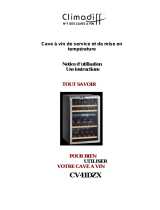
30
Prestigious Bordeaux wines – Reds 16 – 17°C
Prestigious Burgundy wines – Reds 15 – 16°C
Prestigious dry white vintages 14 – 16°C
Light, young, fruity reds 11 – 12°C
Provence rosés, primeur wines 10 – 12°C
Dry whites and vin de pays reds 10 – 12°C
Vin de pays whites 8 – 10°C
Champagnes 7 – 8°C
Sweet wines 6°C
7. MAINTENANCE
Before cleaning your appliance (something to be done regularly), disconnect it by removing the plug or by pulling
the fuse on the circuit.
Before using your appliance for the first time and regularly after that, we recommend that you clean the inside and
outside (front, sides and top) with warm water mixed with a gentle cleaning product. Rinse with clean water and
allow to dry before reconnecting. Do not use solvents or abrasives.
Wash the plastic coating on the steel shelves with a mild detergent solution and then dry with a soft cloth.
Wooden shelves require no particular maintenance.
When the appliance is switched on for the first time, there may be a residual odour. In that case, run the appliance
empty for a few hours at the coldest possible temperature. The cold will kills any odours.
8. STORING YOUR WINE CELLAR
If you will not be using your appliance for short periods, leave the control panel with its usual settings.
During an extended shutdown:
- Remove all bottles from the appliance
- Unplug the appliance
- Thoroughly clean the inside and outside of the appliance
- Leave the door open to prevent condensation, unpleasant odours and mould.
9. WHAT TO DO IN THE EVENT OF A POWER CUT
Most power cuts are resolved within a short time. A power cut of 1 or 2 hours will not affect the temperature in
your cellar. To protect your wines during a power cut, avoid opening the door as much as possible. During very
long power cuts, take the necessary measures to protect your wine.
• If the appliance is disconnected or if there is a power cut, you must wait three to five minutes before re-
starting. If you try to re-start before this time, the compressor will only re-start after 3 to 5 minutes (if the
temperature requires).
• When switching on for the first time or following a prolonged shutdown, it is possible that when re-starting, the
temperatures selected and those displayed are not the same. This is normal. It will take a few hours before
they stabilise.
10. IF YOU NEED TO MOVE YOUR WINE CELLAR
First, disconnect your cellar.
Remove all bottles and secure any loose parts.
To avoid damaging the levelling screws on the feet, screw them tightly into the base.
Move the appliance in an upright position (preferably) or note the direction in which the appliance may be laid
down by looking at its packaging.

















